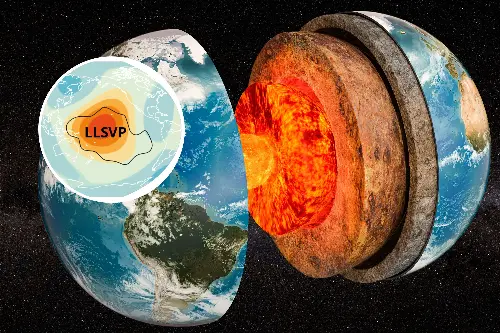
Two enormous continent-sized "islands" found buried deep inside the Earth's mantle are challenging our ideas about our planet's inner workings.
These unexpected regions of the Earth's innards appear to be hotter and older than other structures nearby that are known to be sunken tectonic plates, possibly being around 500 million years old, according to a new paper in the journal Nature.
This indicates that the Earth's mantle might not work the way we think it does, and may be less fast-flowing or well-mixed than anticipated.
These ancient buried "super-continents"—known to scientists as large low-seismic-velocity provinces (LLSVPs)—were found lurking below Africa and the Pacific Ocean, entombed some 1,200 miles below the surface of the Earth.
They were discovered after geophysicists analyzed the waves of earthquakes traveling through these regions of the Earth. As ultrasound can reveal structures deep within our bodies, so can measuring subtle changes to the speed and direction of seismic waves reveals what lies deep beneath our feet.
"Nobody knew what they are, and whether they are only a temporary phenomenon, or if they have been sitting there for millions or perhaps even billions of years," study co-author and seismologist professor Arwen Deuss of Utrecht University in the Netherlands said in a statement.
"These two large islands are surrounded by a graveyard of tectonic plates which have been transported there by a process called 'subduction', where one tectonic plate dives below another plate and sinks all the way from the Earth's surface down to a depth of almost three thousand kilometers."
Plate subduction is a geological process where one tectonic plate moves beneath another as they converge. This typically occurs at plate boundaries, where two plates collide, with the denser plate—typically an oceanic plate—being forced downward into the mantle beneath the less dense plate.
According to the new research, these sunken supercontinents appear to be different from the surrounding remains of subducted crust, as they are much hotter.
"We have known for years that these islands are located at the boundary between the Earth's core and mantle. And we see that seismic waves slow down there," Deuss said.
"The waves slow down because the LLSVPs are hot, just like you can't run as fast in hot weather as you can when it's colder."
However, the hot temperature of the LLSVPs cannot fully explain the properties of the seismic waves they were hearing emanating from these regions deep within the Earth.
The researchers suggest that the buried supercontinent regions must also be made of much larger mineral grains than the buried subducted crust, which would explain the difference in the waves they observed.
"Subducting tectonic plates that end up in the slab graveyard consist of small grains because they recrystallize on their journey deep into the Earth. A small grain size means a larger number of grains and therefore also a larger number of boundaries between the grains," Deuss explained.
"Due to the large number of grain boundaries between the grains in the slab graveyard, we find more damping, because waves loose energy at each boundary they cross. The fact that the LLSVPs show very little damping, means that they must consist of much larger grains."
Just like mineral structures on Earth's surface, like crystals or stalactites, larger mineral grains within the Earth take a lot longer to grow. This therefore indicates that the LLSVPs are much older than the sunken tectonic plates surrounding them.
These larger grains and subsequent older structures also imply that they are not involved in the convection or flow of the mantle, meaning that the mantle may not be as well-mixed as we first thought.
This discovery is hoped to help geophysicists better understand how volcanoes around the world evolve.
"And also to understand other phenomena at the Earth's surface, such as vulcanism and mountain building," Deuss said.
"The Earth's mantle is the engine that drives all these phenomena. Take, for example, mantle plumes, which are large bubbles of hot material that rise from the Earth's deep interior as in a lava lamp."
When these plumes reach the surface, they result in volcanoes forming, spewing forth lava like they recently have in Hawaii and in Iceland.
"We think that those mantle plumes originate at the edges of the LLSVPs."
Do you have a tip on a science story that Newsweek should be covering? Do you have a question about geophysics? Let us know via [email protected].
Reference
Talavera-Soza, S., Cobden, L., Faul, U. H., & Deuss, A. (2025). Global 3D model of mantle attenuation using seismic normal modes. Nature. https://doi.org/10.1038/s41586-024-08322-y
